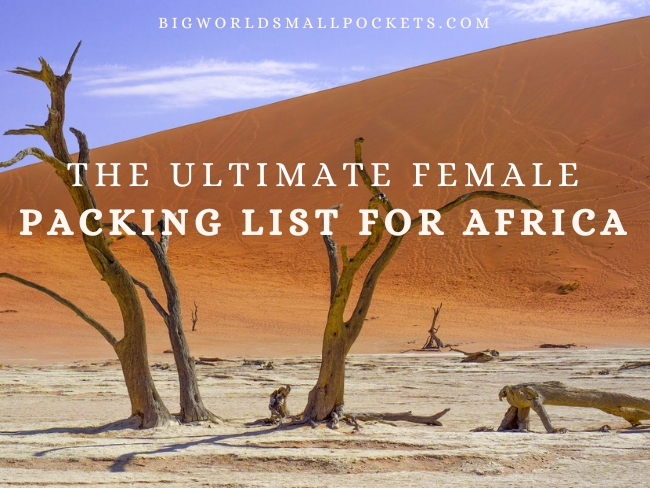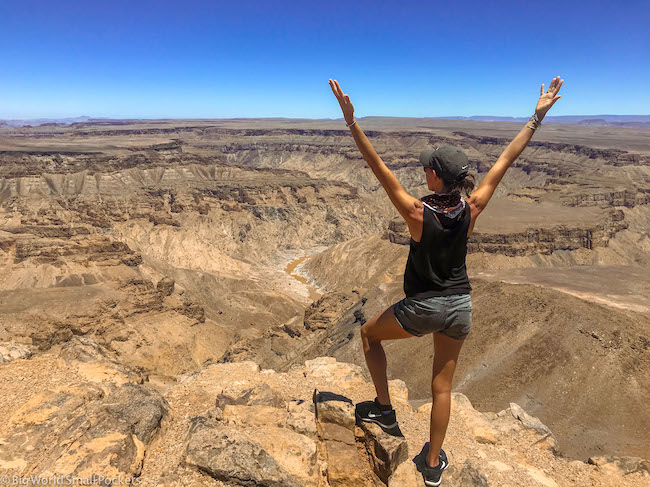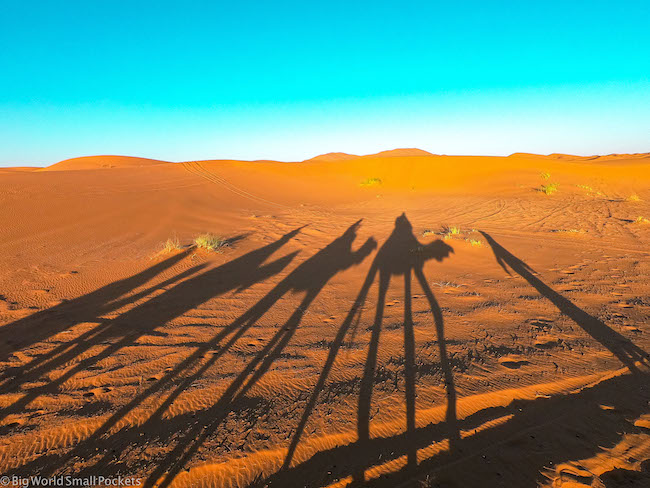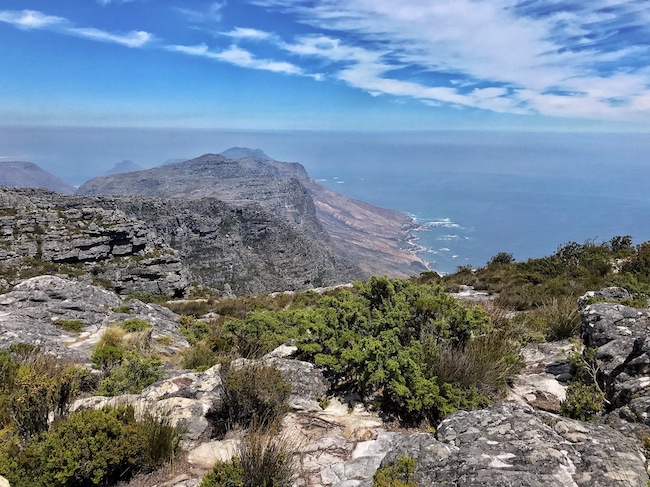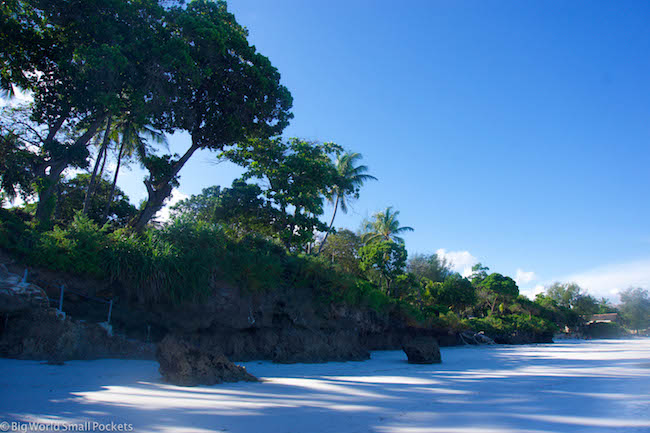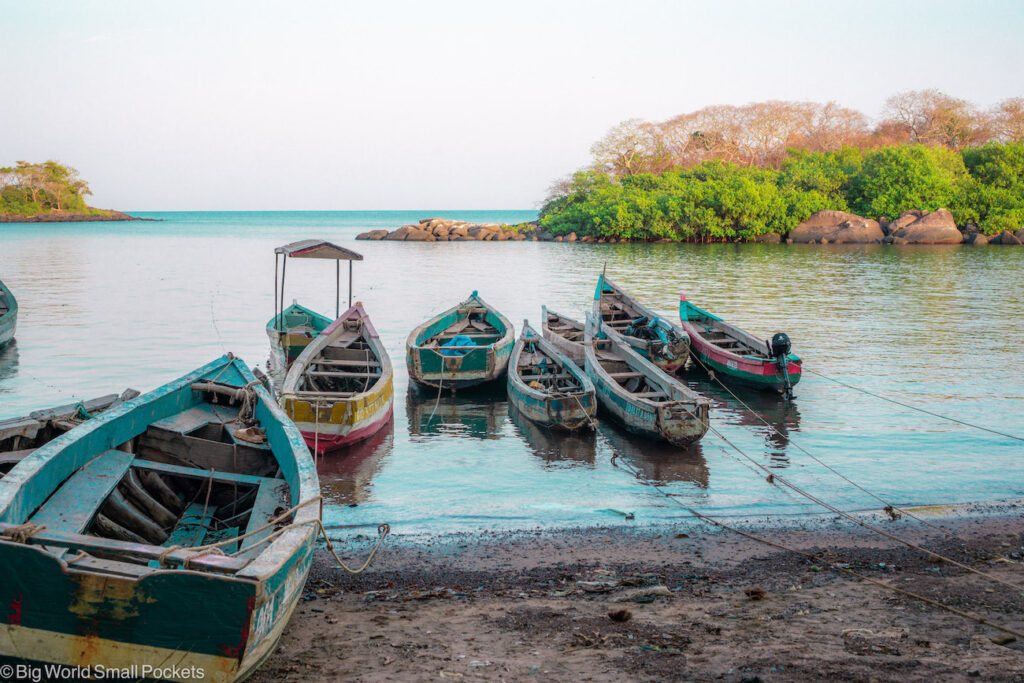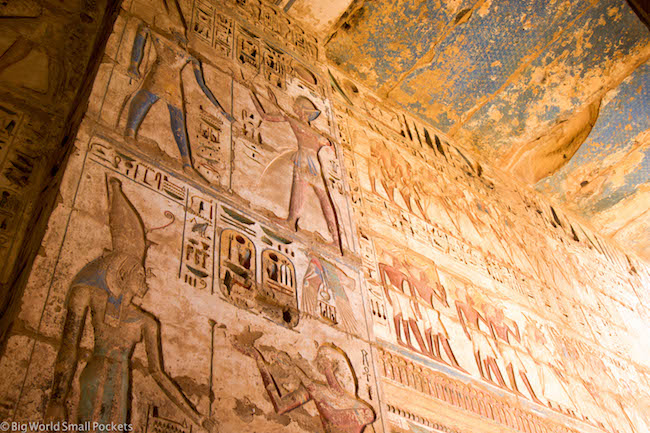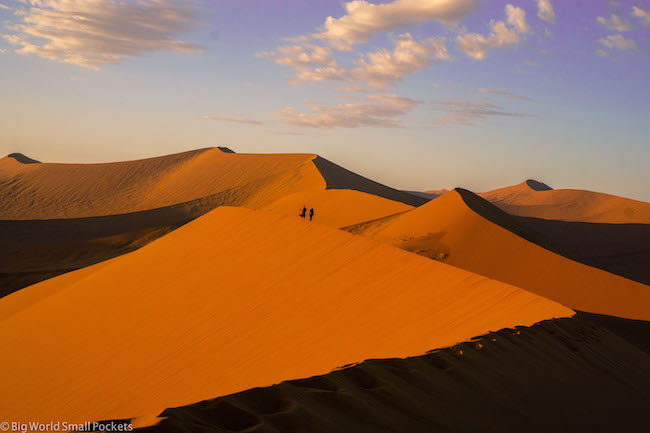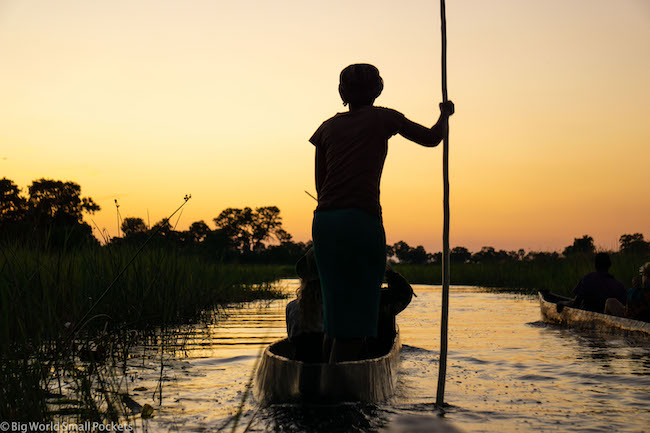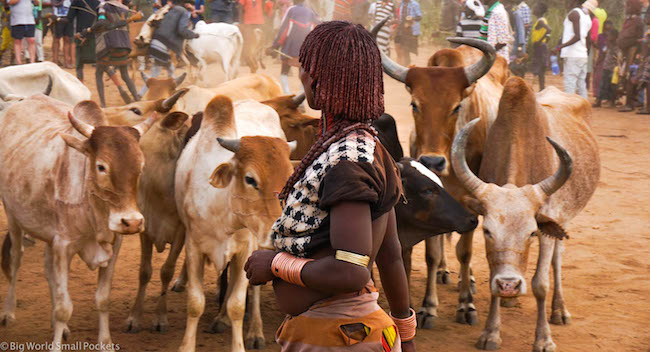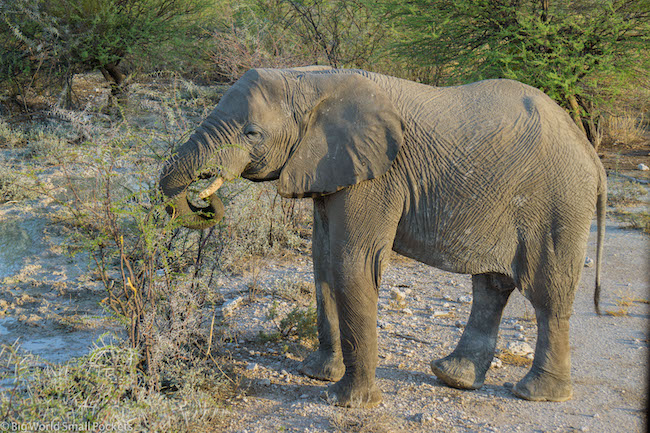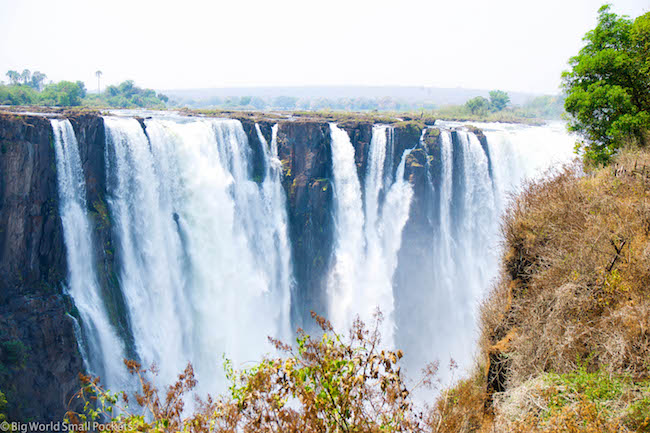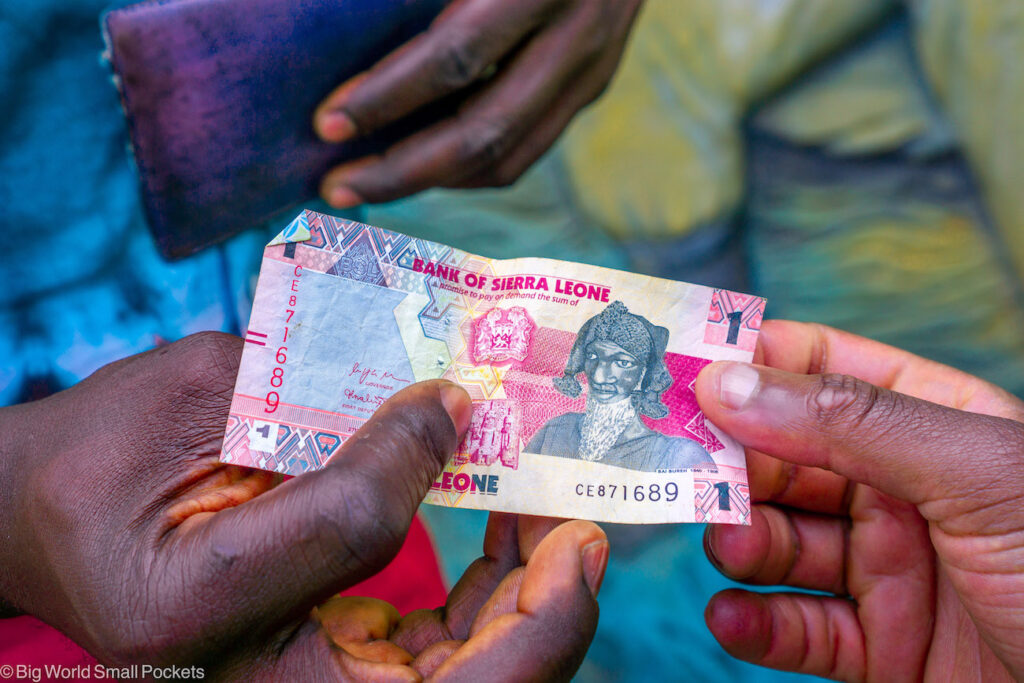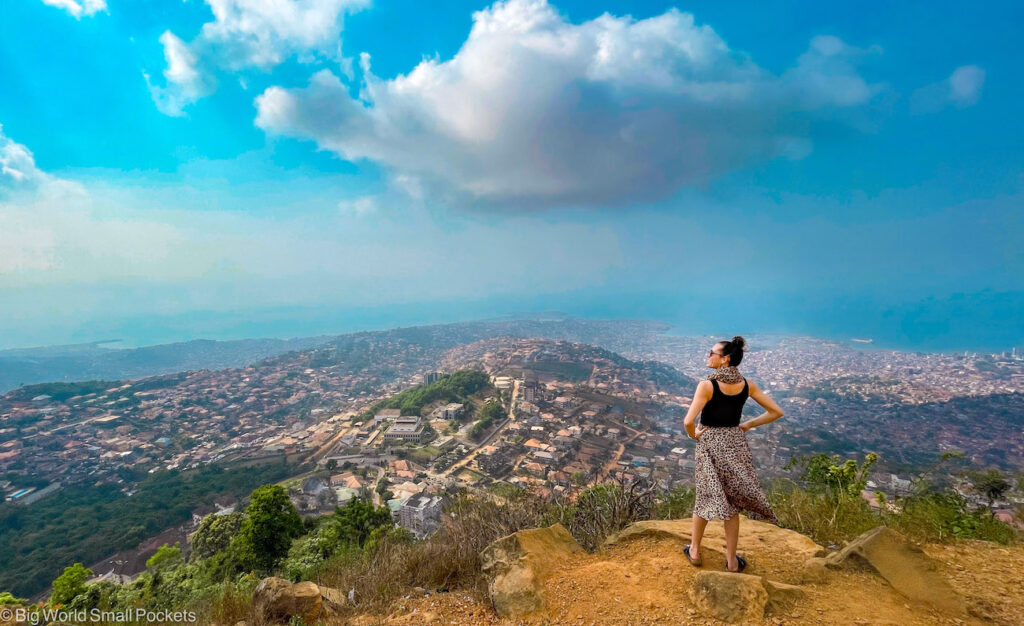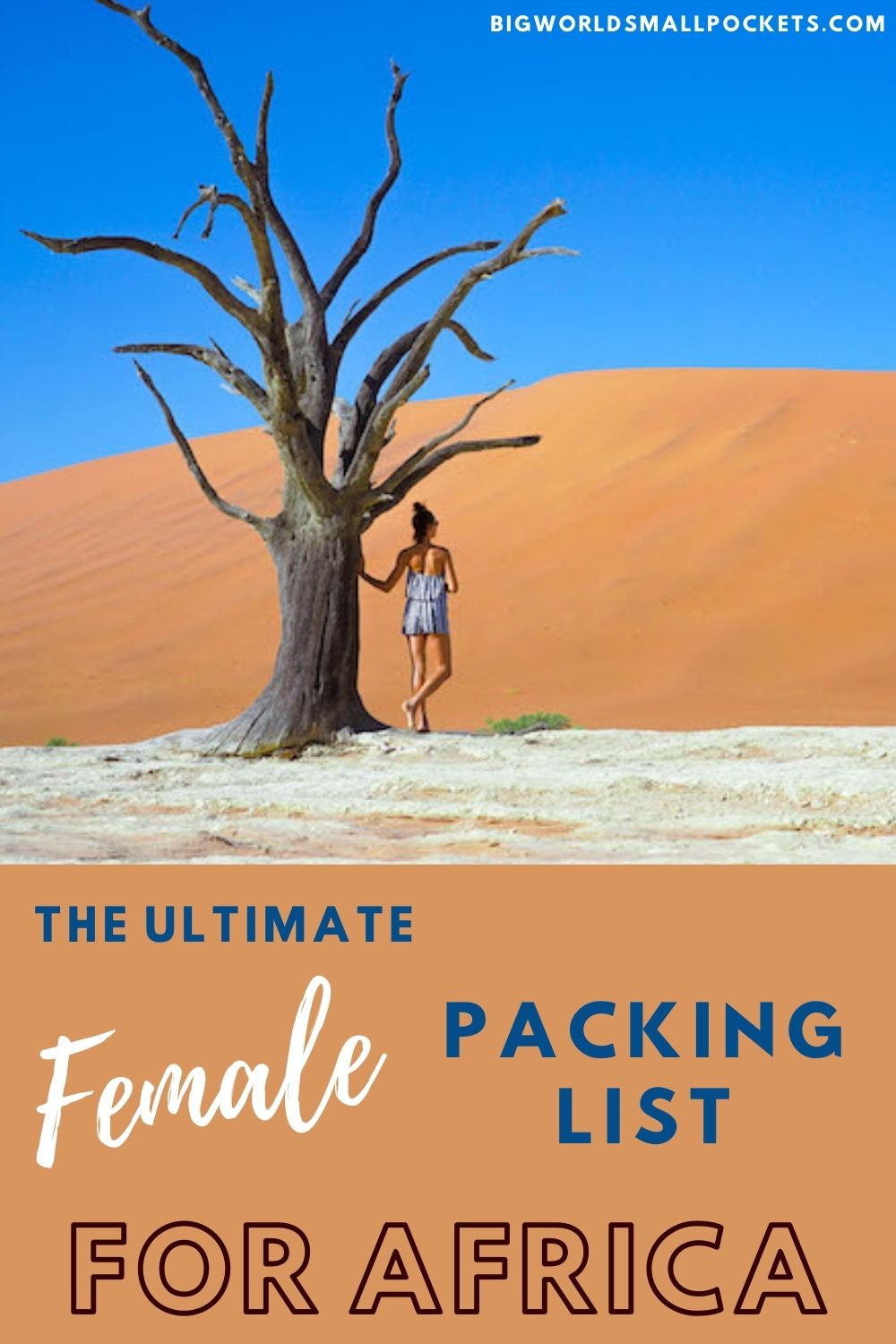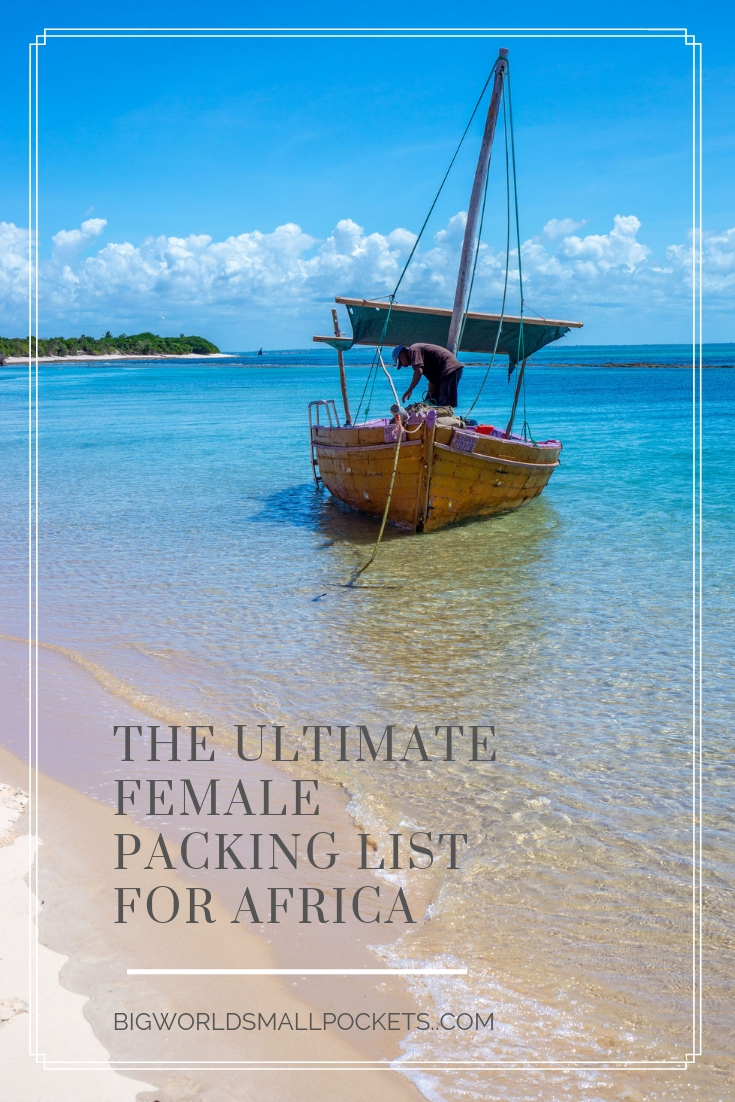Heading off on an African adventure soon? Then here’s the ultimate packing list for your time in this continent – actually the most amazing continent to travel in my opinion!
Lands of epic wildlife, stunning coastline, insane historical sights and rich, vibrant culture await you here and, from the souks of Morocco and the pyramids of Egypt, through to the rich rainforests of Uganda, the beautiful beaches of Mozambique and the wild deserts of Namibia, there’s just so much diversity and splendour out there it’s hard to believe.
And so, for me at least, it’s hard to believe that more people don’t travel in Africa… but that’s the reality.
Many travellers feel anxious about hitting up this continent and I know many solo female travellers do too, so to help allay your fears and prepare you for your adventure, here’s my ultimate female packing list for Africa.
Covering what you need for every destination I’ve visited in this continent, right from cosmopolitan Cape Town up to chaotic Cairo and every land in between, here’s my full and complete guide to everything you need to take with you.
And if you want to take the list away with you, then sign up to download a copy at the bottom of this article
So here goes…
Related Posts
- 10 Best Destinations for Solo Female Travellers in Africa
- 55 Best Things To Do in Africa
- 5 Unforgettable Africa Travel Itineraries
This page contains affiliate links meaning Big World Small Pockets may receive a small commission on any purchases at no extra cost to you.
Grab Your Copy of How to Travel Africa for Less
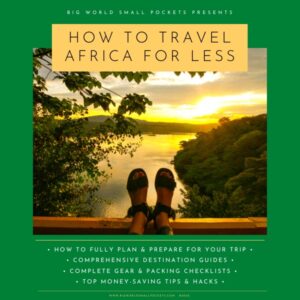
My ultimate guide to travelling Africa on a budget is now available, meaning you can finally get ALL my top tips for adventuring around all, or parts, of this amazing continent in one handy eBook, including…
- Full Planning & Preparation Guides
- Detailed Destination Info
- Complete Packing & Gear Lists
- Top Money-Saving Tips & Hacks
Click Here to Check It Out!
Packing for Africa – Consider Where & When You’re Going
So the first thing to consider when trying to decide what to pack and wear for your travels in Africa is to consider the time of year you plan to go there and which destinations you plan to visit.
As an example, North Africa is best visited during the months of April, May, September and October and you’ll want clothes that will keep you cool in the desert climate, as well as respect the predominant Islamic culture here. You’ll also want swimwear and snorkelling gear for the Red Sea and possibly hiking gear for Morocoo’s Atlas Mountains too!
In contrast, in East Africa, you’ll likely want hiking boots and long pants to protect for during any safari or rainforest hikes, such as to see gorillas or up Mount Kilimanjaro. Again beachwear is a good idea for the Swahili coast, but warmer layers for those dawn and dusk safari drives are also a must.
This is just 2 examples to illustrate the point that being organised with a rough itinerary and timeframe will really help when it comes to packing for an African adventure.
Packing for Days in Cities / Towns
In general, across African cities, I always pair long, loose pants and singlets with a scarf that covers my chest and shoulders. This protects me from the sun and is quite a modest and respectable looks.
I’d also advise wearing closed-toe shoes in most African cities and towns – streets aren’t the cleanest here and there can be a lot of obstacles you risk tripping over.
My Nike Revolution 6 were brilliant across Africa and was glad I went for a black pair as they disguised the dirt more!
A daypack or shoulder bag with a zip fastening – like this Osprey number – is also a great idea for wearing around African towns and cities, as it will allow you to carry water, snacks, your camera, hand sanitiser, wipes, tissues, cash and anything else you might need securely and easily.
What to Wear at Africa’s Islands & Beaches
As the part of the continent probably most used to tourists, beaches and islands across Africa (even in more conservative countries) tend to be a bit more liberal when it comes to clothes, which is great news for those who want to enjoy the sun, sand, sea and even surf!
From Cape Town to Kenya, Senegal to the Sinai Peninsula, you’ll find most visitors are dressed in shorts, small tops, dresses and swimsuits.
And this means it’s fine for you to do the same.
As always, the travel must-have item of a sarong, comes in wonderfully helpful here too and don’t forget the sunscreen, sunglasses and a cap to keep the UV rays off your face too.
A dry bag is also a great idea if you plan to enjoy any boat trips or water activities.
Must Pack Wildlife Spotting Gear
Aside from cities, towns and villages, as well as the beach, the other main outfit you might need to think about when you visit Africa is for wildlife spotting, in particular safaris.
You can learn more in this complete safari gear list I compiled otherwise, loose, comfortable clothes you don’t mind getting wet or dirty is ideal.
Loose long pants and t-shirts are a great option here, along with sunhat to keep the UV off your face.
For some game drives, you might also want a warm hat, thick socks, a windproof coat and a sweater, as things can get chilly at dawn and dusk.
Don’t forget sunglasses and binoculars too.
A sports bra and closed toe shoes are also a great idea for your safari adventures.
Clothes for Flying to Africa
At this point, I also wanted to quickly mention what you might want to wear to fly to Africa.
After all, packing travel clothes that double up, will help keep your overall luggage weight down.
I’d suggest comfortable clothes for flying to this continent, including
- layers to take on and off depending on how cold the plane is – think shawls, blankets, thin long sleeved tops and leggings or trousers
- compression socks – for reducing the risk of DVT
- a travel pillow
- as well as an eye mask and earplugs!
Major airport hubs across Africa include Addis Ababa, Nairobi, Cairo, Casablanca and Johannesburg.
As always, I use Skyscanner to find the best rates on flights and suggest you do the same.
Footwear
Starting off with the feet, there’s a few key footwear pieces I advise packing for your African travels.. although I do warn you not to go overboard!
Practical shoes will be key for travelling this continent, so I suggest leaving your fashion footwear at home!
1x Pair Sandals
Sandals, like birkenstocksbirkenstocks, are great for travel in Africa as they can quickly be thrown on and off.
They provide excellent support for those uneven, dirt roads and won’t break in a flash easily either.
I literally wouldn’t dream of travelling anywhere without my pair now.
1x Pair Runners
Great for hiking or any other vaguely active adventures you may want to do, I love my New Balance runners, which have great grip and tread for all sorts of terrains.
From hiking in Malawi to strolling Cape Town’s Seafront, I can’t tell you how much I’ve used mine!
1x Waterproof Hiking Boots
Essential if you’re going to be trekking to the gorillas or visiting anywhere at altitude, like South Africa’s Drakensberg.
Not only will waterproof hiking boots help with the cold, but it really can rain just about any time of the year in certain parts of Africa and, as such places, quickly become muddy as hell!
Save your runners and your feet and sling on a pair of boots instead.
I took mine on a total whim the first I travelled overland in Africa, but ended up wearing them almost every day in the highlands of Rwanda, Uganda, Tanzania, Kenya and Ethiopia
Clothes
Now we come to the bulk of this packing list – the clothes!
If you’re travelling widely across the continent, then you will need a diverse range of gear as you’ll experience many different climates and cultures.
The key to keeping things light and compact however, is to choose items which are versatile and can easily be layered.
Thin, quick dry and natural fibre items are always the way to go in my opinion.
1x Waterproof Jacket
It has never rained at all during my trips in Southern Africa, but sometimes, in East Africa, I’ve found it barely stopped!
As such, I am always beyond glad to have my thin, lightweight North Face Venture 2 waterproof coat with me because, honestly, you just don’t know when that rains gonna come, and when it does… oh boy!
Not only for the rain, but in the highlands of East Africa and Ethiopia, as well as during those freezing early morning game drives in the Serengeti, the windproof qualities of this jacket really came into its own!
2x Thick Sweaters / Fleece
I splashed out before my first overland Africa trip and bought a merino fleece sweater, which ended up being so useful for those cold nights camping in altitude at Tanzania or during morning safari drives in Zimbabwe.
Again in East Africa, I was glad to have 2 sweaters due to the rain – ensuring at least one was always dry at any given time!
3x Thin Long Sleeved Tops
Perfect to go under your thermal fleece, thin long-sleeved tops are awesome for cold nights and windy early morning safaris.
In the evening, when it’s stinking hot in places like Zanzibar, thin long-sleeved tops offer great mosquito protection too.
And in north African countries, such as Morocco or Sudan, thin long-sleeved tops are great to wear even during the day when, ladies, arms need to be covered.
Try to choose a natural fabric like cotton or merino if you can, as this will stop you sweating as much.
7x Singlets / T-Shirts
Singlets are good for hot days, T-shirts are good for when you need to protect your shoulders from the hot African sun or want to dress fairly moderately in countries such as Egypt or Ethiopia.
Bring a mix of both (perhaps making one or 2 of them quick-dry) and enough to last you a week without washing.
2-3x Pairs Long Thin Trousers
Having some long pants to protect you against evening mosquitos is essential for your time in sub-Saharan Africa, ladies.
Long trousers are also useful for places like Stone Town in Zanzibar and Ethiopia, where is it advised you dress conservatively.
In countries such as Sudan, they are required due to strict sharia law.
Again, I always bat for natural fabrics like linen or cotton first. These ones are ideal.
2x Pairs Leggings
As well as trousers, I’d also suggest putting a couple of pairs of leggings on your Africa packing list too.
Leggings are great to wear under trousers on cold game drives and to wear in bed on cold nights – saving you space on nightwear!
Personally I’m a massive fan of these natural bamboo fibre ones right now!
Leggings also double as great hiking / yoga / active wear if you want to do any fitness whilst you’re on the road and can be paired under a shorter dress if you want something a bit different in the evenings.
2-3x Pairs Shorts
No female Africa packing list would be complete without some shorts for all those beautiful sunny / beach days.
I normally take 2 pairs of denim shorts with me, as well as a pair of Nike Quick-Dry shorts too, but you could get away with just 2 pairs if pushed.
1-2x Beach Dress / Jump Suits/strong>
Just what you’ll want in places like Zanzibar, South Africa or the Kenyan coast!
3x Sarongs / Scarves
Great for beach day blankets, face protection on dusty safari rides, shoulder-covering on scorching hot hikes, as a second towel, a sheet, a dress, a headscarf or a bus blanket, the uses for sarongs go on and on.
Check out my 20 reasons you should always travel with a sarong if you’re looking for any more ideas about the ways this amazing travel item can be used!
I’d mix up a sarong or 2 with a regular scarf or 2, as these will come in super handy in more conservative countries (normally more north Africa), especially when you’ll need to cover shoulders or even your head ladies.
Finally, why not also consider a travel scarf?
These great packing items are ideal for travel days, hiking or on safari, when the hidden security pocket can be used to store your valuables close to your body.
1-2x Bikini / Swimwear
I love my Ripcurl bikini sooo much!
1x Woolly Hat
A godsend when I was up at altitude in the Ngorongoro Crater and Iringa in Tanzania, Eldoret and Nairobi in Kenya and Addis Ababa in Ethiopia.
1x Sun Hat / Cap
Essential for safaris when they pop the roof and you’re without shade for hours at a time.
Also great for beach days in East Africa, summer in Southern Africa and all that ruin spotting / temple trotting you’ll do in North Africa.
I think this one from Hello Sunshine is super cute.
8x Pairs Underwear & 2x Bras +1x Sports Bra
Pack enough underwear so you don’t have to do any washing for a week!
Sports bras are a great idea for those bouncy, rough safari / bus rides, trust me!
Socks
Taking a mix of thin, ankle socks and long, thick hiking socks like these would be my recommendation.
Nightwear
Optional if you’re tight on space.
Sunglasses
Essential!
Get UV-rated ones with anti-scratch and polarised lenses. Worth the investment!
Electricals
No one wants to be travelling with too much heavy or expensive electrical equipment, but it’s inevitable that you’ll be carrying a bit with you.
Here’s the essentials you should pack for your trip to Africa…
Laptop / Tablet + Charger
Download Netflix stuff before you leave home and enjoy some relaxing watching during your African evenings on your tablet.
Alternatively, laptops will allow you to backup any photos onto an external hard drive / cloud software.
Smartphone & Bluetooth Headphones
All the campsites / hostels I’ve stayed at in Africa have wifi, so taking your smartphone to stay in touch with those at home and upload some pics to social media is a great idea.
Also good to know that in most Africa countries, SIM cards are cheap and easy to get hold of!
I’d highly recommend downloading some audiobooks and music onto your phone before you leave home too – a great idea for longer journey days.
Amazon Audible and Spotify Premium are my go-to services for these purposes.
And when it comes to Bluetooth headphones, you can’t beat the Airpods in my opinion!
Mirrorless Camera
I love my Sony A6000 mirrorless camera which is lightweight, compact and study – perfect for Africa travel.
I’ve used mine across the continent and wouldn’t be without it!
2-3x Camera Lens
My Sony A6000 mirrorless camera came with a 16-50mm optical lens, but it’s definitely worth putting a good zoom lens on your Africa packing list too, especially for any safaris.
My 65-210mm lens was perfect for this and not too expensive either!
You may also want to consider a prime lens for any portraits.
Just remember to always ask permission before you start snapping.
Fast SD Memory Cards
Get large 64GB SD memory cards as you do not want to run out of photo space when in Africa and these sorts of things can be hard to come by over there.
I’d also recommend splashing out a bit and getting some fast-processing memory cards – just what you need to snap that running cheetah!
Depending on how long your trip is, I’d take 2-3x SD memory cards.
Spare Camera Battery + Cleaning Kit + Charging Cables
You never want to run out of battery when there is a leopard in front of you… trust me!
This means having a spare charged battery for your camera on you is a great idea when travelling in Africa.
Cameras also get dusty a lot across this continent, so a small camera cleaning kit is a must.
And finally, don’t forget the charging paraphernalia!
Adapter Plugs + Spare Cables
I took a
South African adapter for South Africa, Namibia, Mozambique, Eswatini & Botswanaa British Adapter for Zimbabwe, Zambia, Malawi, Tanzania, Uganda & Kenya
and a European adapter for Ethiopia, Rwanda, Morocco, Sudan & Egypt.
They all add up but are definitely needed!
Alternatively, check out the Skross selection of world adapters to cover all bases.
And don’t forget to include spare micro USB leads in your Africa packing list too, as they always get lost / broken!
Portable Charger
Portable chargers are great when travelling in countries without solidly reliable power sources, like in most of Africa!
I recommend the Anker PowerCore which has 2 output sources, meaning I could charge my phone and my camera at the same time at lightning speed – BOOM!
Toiletries
My toiletries list is always longer than it should be, but taking care of yourself when you’re travelling Africa is really important, so here’s my definitive list…
Thin Toiletries Bag
To hook or not to hook? That is the question! Personally, I always hook!
Either way, just make sure it is light and thin.
This one is a great, economical option
Shampoo and Conditioner Bars
Lush have the best supply and they last for ages!Say goodbye to mid-travel spillages and bulky bottles people, this is the plastic-free future!
Anti-Bacterial Soap
Great for life in those sweaty, humid climates, trust me!
Keep it in a ziplock bag when travelling.
Deodorant
I love natural crystal deodorants – no nasty chemicals and they last FOR AGES!
30+ SPF Sunscreen
Try to get a chemical-free product like this one.
SPF Chapstick
Burts Bees are always my go to for SPF chapstick.
Menstrual Cup
Ye yeah ladies, you know what I’m talking about!
If not, check one out here – the future for the environment and your body.
Toothbrush, Toothpaste, Floss
Face Cleanser, Toner, Serum & Moisturiser
Body Moisturiser
Razor & Spare Blades
Cotton Buds & Pads
Hair Bands & Hair Brush
Glasses / Contact Lenses if you wear them
Tweezers & Safety Pins
Nail Scissors, Nail File, Nail Varnish, Nail Varnish Remover
Small First Aid Kit
A small first aid kit is a great idea when packing for Africa travels, as it’s best to be prepared over there.
This short list covers most of the essentials…
Anti-Malaria Medication
Please consult a health professional on this one before you depart for Africa.
DEET Insect Repellent
I recommend 30% DEET, which is enough to deter those pesky nippers, but safe enough for children to use.
Tiger Balm
Great for aching muscles and soothing insect bites, this is travel-must for me.
Tea-Tree Essential Oil
A powerful antiseptic, anti-mould and anti-fungal treatment.
Also great to throw in a few drops with your washing and ideal for freshening up smelly bags / laundry etc.
Get an organic tea-tree oil if you can.
Rehydration Salts & Immodium
Painkillers, Anti-Inflammatories & Antihistamines
Band Aids & Bandages
Anti-Septic Cream
Other Items to Pack for Africa Travels
And finally, here’s a number of other key items I think are must-haves on your Africa packing list.
Practical and incredibly useful, all of these items will help your travels here run as smoothly as possible…
Day Pack
Good for hiking and beach days, this one from Pacsafe is great option.
Sleeping Bag and Silk Liner
I love my snugpak sleeping bag, which condenses down to nothing and my silk sleeping bag liner, which is perfect for keeping me cool and sweat-free at night when it’s humid af.
Mosquito Net
It’s a great idea to pack a travel mosquito net for those times when the one provided is less than adequate!
Or when you want to sleep out under the stars but still not get bitten!
Headlamp & Spare Batteries
An absolute necessity on your Africa packing list in a continent where power supply can be patchy at best!
Make sure you take one with a red setting to deter those insects and bugs at night.
My Black Diamond Storm model never leaves my side!
Binoculars
You can easily get cheap pairs like these ones from Eurohike, which are ideal for those travelling Africa on a budget.
I have this exact pair and they are both lightweight and durable.
Travel Towel
Compact, quick dry and all-round brilliant!
I love my one from Latrek, which is super lightweight, thin, soft, quick drying and never smells!
Travel Cutlery Set & Multi-Tool
Lots of people say you don’t need these, but I find a travel cutlery set very helpful – a must if you want to go to markets and prepare a picnic on the go.
Choose a light, inexpensive set and make sure the multi-tool has a bottle opener, corkscrew and knife – like this.
Filter Water Bottle
Needless to say, I wouldn’t advise drinking the tap water in Africa, so buying bottled water, or taking a filter water bottle are your only real options.
Personally, the second of these is by far the better option in my opinion as it will save you money, save you hassle and, most importantly, hugely reduce your plastic waste as well.
Enter the Water-To-Go bottle!
A genius invention that allows you to safely drink the tap water anywhere in the world, these guys are easy to use and incredibly secure and hassle-free.
Love mine! Used it across Africa and wouldn’t be without it now!
Combination Padlock
Ideal for locking up your bag during transit, stuff on an overland truck or keeping your valuables safe in lockers at backpackers.
Travel Sewing Kit
You just never know how handy this will be!
Travel Washing Line & Hand Wash
Travel washing lines are the best and especially in Africa, where laundry facilities are thin on the ground, I wouldn’t be without mine.Sea to Summit do this great pocket travel handwash.
Eye Mask & Earplugs
Key for sleeping on long bus journeys, in tents and in hostels.
This eye mask from Alaska Bear is super comfy.
Travel Guide eBook
I just love Lonely Planet’s eBook range.
They take up no space, weigh nothing and are chock full of great info.
They do a complete Africa travel guide, a Southern Africa guide, an East Africa guide, as well as a whole range on individual countries.
Worth checking out.
Toilet Paper & Wet Wipes
Take the cardboard centre out of the toilet paper and condense these bad boys!
Bring multiple packs of wet wipes… I’ve never used so many in my life as I have in Africa!
Needless to say, the biodegradable options are the best.
Documents
And last but not least, don’t forget these all-important documents you’ll need for your adventures in Africa…
Passport & Photocopies
Flight Tickets
Visa Documentation
USD Cash in Small Thin Purse
Credit Cards and Debit Cards
You want to ensure you’re not being charged overseas transaction fees or getting poor exchange rates when using your card in Africa, which is why I always take my Wise card away with me wherever I travel.
The easy way to spend abroad with real exchange rates, no markups and no sneaky transaction fees, you can use your Wise card just like a debit card across this continent… and it links easily with Google and Apple pay – sold! Grab yours here.
Immunisation Documentation
Always good to have with you, especially proof of your yellow fever certificate if it is required by your intended destination(s).
Travel Insurance
World Nomads offers simple and flexible travel insurance. Buy at home or while travelling and claim online from anywhere in the world.
Alternatively, if you’re a long-term traveller, digital nomad or frequent remote worker seeking travel health cover, check out Safetywing’s Nomad Insurance policies.
Just enter your details below and I'll email it you - simple!
Information will be sent to the email provided above
Mini Travel Guide to Africa
When to Visit?
As a huge continent, it’s impossible to give an overall best time to visit Africa, so I’ve split this question down in sub-regions.
When it comes to North Africa, I highly recommend visiting during the spring and autumn months, ie. April to May and September to October, so that the weather is pleasant enough for sightseeing.
In West Africa, the high season runs from December through February, when the region generally experiences its lowest rainfall and humidity – definitely a good idea to visit at this time!
In East Africa, visiting during the long dry season is a great idea.
In general, this runs between the months of July and September and also conveniently aligns with the Great Migration too. The short rainy season in November and December can be another good time to visit this part of the continent.
And finally, we come to Southern Africa.
If you’re heading to Cape Town, I’d visit between November and February, but for Namibia and Botswana, the best months are May through October when it’s cooler and less humid.
Best Tours in Africa
If you’re interested in an unforgettable, well-priced tour across Africa, with guides you can trust, or a self-drive trip organised by a great company, then email me at [email protected] and I’ll send you my top recommendations – simple!
Alternatively, I’m currently offering my readers an exclusive discount on all Absolute Africa tours, meaning you can now travel even more in the amazing regions of southern and east Africa for even less! Simply send this top African overland tour company an email to [email protected], quoting the discount code BWSP, and start planning your incredible trip with them today!
Otherwise, if it’s strictly safari tours you’re looking for, check out these top picks.
SAVE THIS TO PINTEREST!
So there you have it, my ultimate packing list for Africa
Have you made it to this continent yet?
What was top of your packing list and what did you bring that you did not need?
Please join the conversation in the comments box below…

